

XLF-962+ Reflectionless RF Filter: High-Performance, Low-Reflection Solution
Catalog
General DescriptionKey BenefitsApplicationsFeatures and AdvantagesElectrical SpecificationsSPECIFICATION DEFINITIONSIMPLIFIED SCHEMATIC AND PAD DESCRIPTIONPRODUCT MARKINGTypical PerformanceREFLECTIONLESS FILTER APPLICATION NOTEApplication ExampleConclusionFrequently Ask QuestionsGeneral Description
Mini-Circuits’ XLF-962+ reflectionless filter uses an innovative design that absorbs and terminates stopband signals inside the device instead of reflecting them back to the source. This unique feature opens up new possibilities for filter applications beyond what conventional designs can achieve. Traditional filters reflect stopband signals at full power back to the source, which can cause unwanted interactions with nearby components, leading to intermodulation and other types of interference. By eliminating stopband reflections, reflectionless filters can be directly integrated with sensitive components and applied in situations that would normally require additional circuitry, such as isolation amplifiers or attenuators.
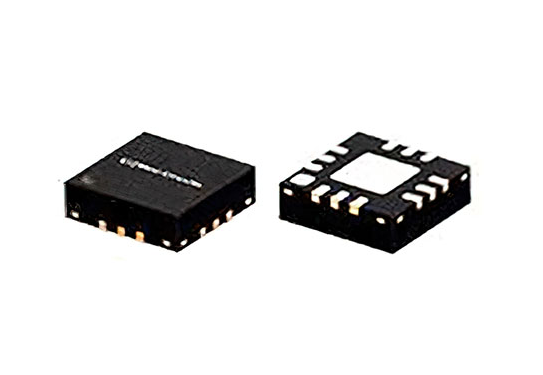
XLF-962+ Reflectionless RF Filter
Key Benefits
- 50Ω matched in the stopband, preventing unwanted reflections
- Cascadable for flexible design options
- High power handling capability
- Reliable performance at temperatures up to +105°C
- Compact size: 3 x 3 mm package
- Protected by US Patent No. 8,392,495
Applications
- Harmonic suppression
- Satellite systems
- Radar equipment
- Military and aerospace solutions
Features and Advantages
- Reflectionless Technology These filters absorb unwanted signals instead of reflecting them back to the source. This minimizes the creation of spurious signals without needing extra components like attenuators, improving system dynamic range and reducing board space requirements.
- 50Ω Match in the Stopband The filters maintain proper impedance matching even in the stopband, enabling seamless integration with high-gain, wideband amplifiers while avoiding out-of-band instabilities.
- Consistent RF Performance for Production Built on a GaAs process, X-series filters deliver inherently repeatable performance, making them highly reliable for large-scale manufacturing.
- Outstanding Temperature Stability With only ±0.3 dB variation across temperature, these filters are well-suited for wide temperature range applications, eliminating the need for additional temperature compensation.
- High Power Handling in a Compact Size Strong power handling capabilities make these filters suitable for transmit paths and inter-stage filtering, all within a space-saving compact package.
Electrical Specifications
ELECTRICAL SPECIFICATIONS1 AT +25°C
| Parameter | Frequency Range (MHz) | Min. | Typ. | Max. | Unit |
|---|---|---|---|---|---|
| Passband | |||||
| Insertion Loss | DC – F1 (DC – 9600) | — | 1.4 | 2.0 | dB |
| 3 dB Cut-off F2 | 12400 | — | 3.0 | — | dB |
| VSWR | DC – F1 (DC – 9600) | — | 1.2 | — | :1 |
| Stopband | |||||
| Rejection | F3 – F4 (14800 – 16000) | 12 | 14 | — | dB |
| F4 – F5 (16000 – 25200) | 16 | 20 | — | dB | |
| VSWR | F3 – F4 (14800 – 16000) | — | 1.3 | — | :1 |
| F4 – F5 (16000 – 25200) | — | 2.4 | — | :1 |
Absolute Maximum Ratings
| Parameter | Rating |
|---|---|
| Operating Temperature | -55°C to +105°C |
| Storage Temperature | -65°C to +150°C |
| RF Input Power (Passband, DC–F1)³ | 2 W at +25°C |
| RF Input Power (Stopband, F2–F5)⁴ | 80 mW at +25°C |
Notes
- Permanent damage may occur if any of these limits are exceeded.
- Passband power rating derates linearly to 1 W at +105°C ambient.
- Stopband power rating derates linearly to 40 mW at +105°C ambient.
SPECIFICATION DEFINITION
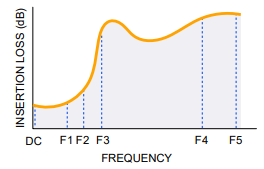
SPECIFICATION DEFINITION
SIMPLIFIED SCHEMATIC AND PAD DESCRIPTION
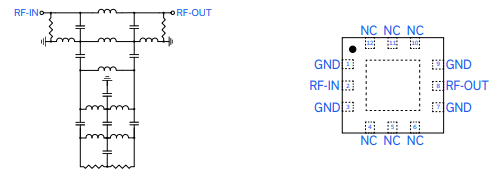
SIMPLIFIED SCHEMATIC AND PAD DESCRIPTION
Pin Descriptions
| Function | Pad No. | Description |
|---|---|---|
| RF-IN | 2 | RF input pad |
| RF-OUT | 8 | RF output pad |
| GND | 1, 3, 7, 9, Paddle | Connect to ground |
| NC (Externally GND) | 4, 5, 6, 10, 11, 12 | No internal connection (tie to ground externally) |
PRODUCT MARKING

PRODUCT MARKING
Marking may contain other features or characters for internal lot control
Typical Performance
TYPICAL PERFORMANCE DATA AT +25°C
| Frequency (MHz) | Insertion Loss (dB) | VSWR (:1) |
|---|---|---|
| 10 | 0.38 | 1.04 |
| 100 | 0.31 | 1.02 |
| 400 | 0.30 | 1.08 |
| 800 | 0.33 | 1.17 |
| 1500 | 0.39 | 1.25 |
| 2500 | 0.46 | 1.23 |
| 3500 | 0.49 | 1.16 |
| 5000 | 0.61 | 1.22 |
| 6500 | 0.72 | 1.19 |
| 8000 | 0.88 | 1.16 |
| 9600 | 1.35 | 1.54 |
| 11000 | 2.10 | 1.86 |
| 12400 | 2.89 | 1.40 |
| 14800 | 14.50 | 1.37 |
| 16000 | 28.82 | 1.18 |
| 18000 | 23.70 | 2.65 |
| 20000 | 20.53 | 2.37 |
| 22000 | 25.19 | 1.69 |
| 24000 | 22.94 | 2.90 |
| 25200 | 19.51 | 3.79 |
XLF-962+ INSERTION LOSS
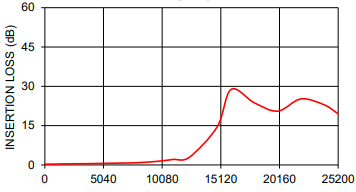
XLF-962+ INSERTION LOSS
XLF-962+ VSWR
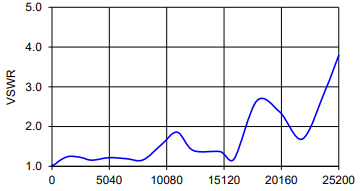
XLF-962+ VSWR
Additional Information
- Performance Data Typical Data Tables Performance Graphs S-Parameter Files (S2P) available for download (.zip)
- Case Style DQ1225: Plastic package with exposed paddle Lead finish: Matte-tin
- Tape & Reel Options Standard reel sizes available F66: 7” reels with 20, 50, 100, 200, 500, 1000, 2000, or 3000 units
- Recommended PCB Layout Layout drawing: PL-451
- Evaluation Boards TB-844-962+ (without connectors) TB-844-962C+ (with connectors) Optional connector: B20-118-F1+ (sold separately)
- Environmental Ratings Document reference: ENV82
ESD RATING
Human body model (HBM): Class 1A (250 to <500V) in accordance with ANSI/ESD 5.1-2001
MSL RATING
Moisture Sensitivity: MSL1 in accordance with IPC/JEDEC J-STD-020D
REFLECTIONLESS FILTER APPLICATION NOTE
Application Circuit Example: Pairing mixers with reflectionless filters to improve system dynamic range
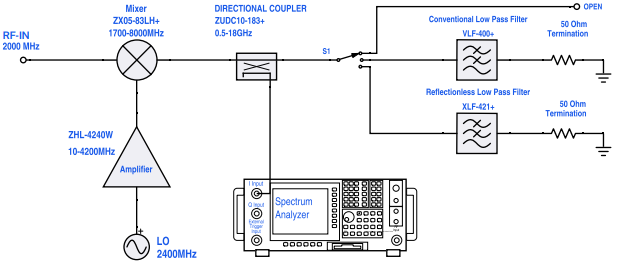
Test block diagram: IF output reflection spectrum with single input frequency
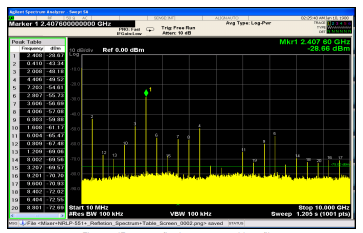
Figure 1. IF output reflection spectrum without filter
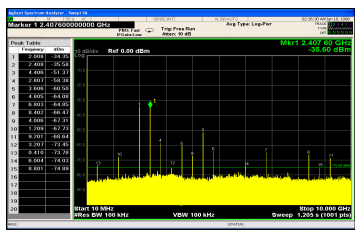
Figure 2. IF output reflection spectrum with conventional filter
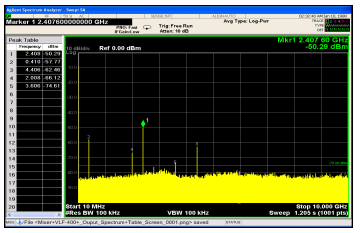
Application Example
An evaluation circuit was built to compare the IF reflection spectrum at a mixer’s output when paired with a conventional filter versus a reflectionless filter. While a conventional filter reduces reflections compared to using the mixer alone (without any filter), the reflectionless filter goes further by nearly eliminating reflections entirely.
At marker 1 in the measurement figures, the reflected signal shows a reduction of more than 20 dB — from -28.7 dBm down to -50.3 dBm — when the reflectionless filter is used instead of the conventional filter. This significant improvement eliminates unwanted spurious mixing products and enhances overall system dynamic range.
For additional details, see Application Note AN-75-007.
Notes
A. Any performance or quality attributes not expressly specified in this document are excluded and are not part of this specification.
B. Electrical specifications and performance data are based on Mini-Circuits’ established test methods and measurement procedures.
C. Products described in this document are subject to Mini-Circuits’ standard limited warranty and terms and conditions (“Standard Terms”). Purchasers are entitled only to the rights and remedies set forth in those terms.
Conclusion
The XLF-962+ reflectionless filter delivers low insertion loss, excellent stopband rejection, and stable performance across wide temperatures, all in a compact package. By eliminating reflections, it improves system dynamic range and simplifies integration with sensitive RF components, making it a reliable choice for demanding applications in satellite, radar, military, and aerospace systems.
Frequently Ask Questions
What is a reflectionless filter, and how does it differ from a conventional filter?
A reflectionless filter absorbs stopband signals instead of reflecting them back to the source. Unlike traditional filters that reflect unwanted signals and can cause intermodulation or instability, reflectionless filters prevent these issues, enabling safer integration with sensitive RF components.
What frequency range does the XLF-962+ cover?
The XLF-962+ offers a passband from DC to 9.6 GHz, with strong stopband rejection up to 25.2 GHz. It maintains low insertion loss across the passband while providing high attenuation in the stopbandHow much insertion loss can I expect in the passband?
Typical insertion loss is 1.4 dB, with a maximum of 2.0 dB across DC to 9.6 GHz. This ensures minimal signal degradation in the passband.
How well is the XLF-962+ matched in the stopband?
The filter maintains a 50Ω impedance match in the stopband, allowing it to work safely with high-gain, wideband amplifiers without causing out-of-band instabilities.
Can the XLF-962+ handle high RF power?
Yes. In the passband, it can handle up to 2 W at +25°C (derating to 1 W at +105°C). In the stopband, it can handle 80 mW at +25°C (derating to 40 mW at +105°C).
How stable is the XLF-962+ over temperature variations?
The filter shows excellent stability, with only ±0.3 dB variation across its operating range of -55°C to +105°C, making it ideal for wide temperature range applications.
What are the package and mounting options?
The XLF-962+ comes in a DQ1225 plastic package with an exposed paddle for grounding. It is available in tape & reel formats (7” reels) with quantities from 20 to 3000 units. Recommended PCB layout is PL-451.
Are there evaluation boards available for testing?
Yes. Evaluation boards TB-844-962+ (without connectors) and TB-844-962C+ (with connectors) are available. Optional connectors can be purchased separately (B20-118-F1+).
What kind of performance improvement can I expect compared to conventional filters?
Application testing shows that reflections can be reduced by more than 20 dB compared to conventional filters, eliminating spurious mixing products and improving system dynamic range.
Where can I find more technical information and specifications?
Additional resources include S-parameter files (S2P), performance graphs, application notes (e.g., AN-75-007), and Mini-Circuits’ standard specifications and environmental ratings (ENV82).
Subscribe to JMBom Electronics !













